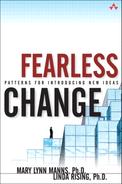Time for Reflection
How noble and good everyone could be if, every evening before falling asleep, they were to recall to their minds the events of the whole day and consider exactly what has been good and bad. Then, without realizing it, you try to improve yourself at the start of each new day; of course, you achieve quite a lot in the course of time. Anyone can do this, it costs nothing and is certainly very helpful.[*]
—Anne Frank at age 15
To learn from the past, take time at regular intervals to evaluate what is working well and what should be done differently.
![]()
You are an Evangelist(144) or Dedicated Champion(129) using Test the Waters(237) to try to introduce a new idea into your organization.
We make the same assumptions and the same mistakes based on those assumptions over and over again.
It is much easier to keep doing what we’ve always done than it is to stop and think about whether it is the best thing to do. In our attempts to use every moment, we rush to do this, to do that. Keeping this continual pace makes it difficult to step back and reflect, to take a broader view. It can be uncomfortable to do this because we may discover that what we are doing is no longer working. Yet, Betty Sue Flowers, author of The Power of Myth, explains that most of us create the future by extrapolating from the past.
In the movie Dances with Wolves, a tribe of Native Americans takes time to examine the success of a buffalo hunt by telling and retelling the story of the hunt around a campfire. This is an important ritual because it provides lessons for all the hunts to come. It is the way wisdom is passed on. A retrospective works in much the same way. Its purpose is to help review a recent project to understand what worked well and what can be done differently next time.
In 1988, Joseph M. Juran wrote about deriving lessons learned from retrospective analysis and named this process after philosopher George Santayana, who once observed, “Those who cannot remember the past are condemned to repeat it.” Many large organizations have some form of the Santayana review and call it a retrospective, postmortem, postpartum, or project review. The idea is simple—examine what happened on the last project and learn from it.
Even failed projects can identify valuable accomplishments for which a team can be proud. At the same time, even in the most successful project, things can be improved. To create learning organizations, we must make it a practice to discuss what went on in our projects. Similarly, to learn as an individual, we must take the time to reflect. President Lincoln stated that we may learn more from what has not been done right than what has been done right. But learning doesn’t happen unless we allow time for it.
Therefore:
Pause in any activity to reflect on what is working well and what should be done differently.
Take time out at regular intervals. Reflection is more likely to occur if it is made part of the process rather than something that may happen when you have time. Build reflection time into the process as you apply Step by Step(224) and evaluate the adjustments to make in your strategy. When you celebrate Small Successes(216), talk with others about what is going well and what should be done differently. Even when things aren’t going as well, you don’t need to feel bad about making mistakes as long as you take the trouble to learn from them. For you often learn more by being wrong for the right reasons than you do by being right for the wrong reasons.
To reflect as a group, run a project retrospective, a series of fun and highly effective activities that help a team review the past so that the members can become more productive in the future. Use Location, Location, Location(189) if possible. For more information on leading a retrospective, see Norm Kerth’s excellent book Project Retrospectives.
= = = = = = = = =
This pattern helps you understand what happened in the past and what can be improved in the future. You’ll see things that hadn’t occurred to you. You can plan your next step, note the things that are going well, and think about how you can improve. You can even document your successful practices so that they can be shared with others.
But you have to carve out time to reflect, and this isn’t easy in our fast-paced world. Yet, it can be argued that failing to think about the past and plan your next step can cause you to lose even more time in the long run because of the mistakes you may be making over and over again.
“Every day, I have to make difficult decisions, and I base them primarily on what has happened in the past,” says Nathan Myhrvold, Chief Technology Officer of Microsoft Corporation. “History can lead you to see important abstractions, and it also offers great lessons….If you want to make good decisions about what’s to come, look behind you.”[*]
Blockbuster Inc. wanted to increase the amount of time their employees spent with customers by decreasing some of their administrative duties. They made observations and brainstormed suggestions from the people doing the work. Their reflection created some improvement. For example, employees changed their reshelving process by putting videos/DVDs on a cart so that customers taking movies off the cart would reduce the effort of putting them back. As a result of some process changes, employees have gone from spending 36% of their time with customers to 50% and climbing. They learned that a company can conceive of new ideas for improvement when they stand back and reflect on what they already do.
